Wellesley Hills
Beth Hinchliffe writer
Larry Buckley photographer
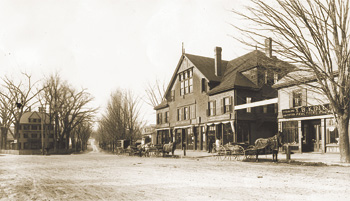 First it was called “Nehoiden.” Then, “the Port.” For a while it was “North Needham,” later “Grantville,” and when Wellesley gained its independence, it finally took on its permanent name: “Wellesley Hills.”
First it was called “Nehoiden.” Then, “the Port.” For a while it was “North Needham,” later “Grantville,” and when Wellesley gained its independence, it finally took on its permanent name: “Wellesley Hills.”
It’s a place that feels like a separate village, where a network of little neighborhoods lies within walking distance of mom and pop stores. The Hills is part of Wellesley, but it’s also more; it’s an area with distinct borders and a distinctive past; with its own post office, railroad station, churches, library, landmarks, and story.
“It’s a combination of things that makes the Hills special—the natural setting, with the extraordinary open space to enjoy; the beautiful old buildings and compelling history; and something unique about the social fabric of the area, that I’ve never found anywhere else,” says selectman and longtime resident Greg Mills, who is following in the footsteps of his ancestor Benjamin Mills, who lived nearby and was elected selectman in 1711.
From the beginning, the Hills grew as a self-sufficient mini-town, and through the centuries its residents have fought proudly, and sometimes fiercely, to maintain its unique identity.
In those early days the center of life was Sargent’s Tavern, where the Clock Tower is today. When the new Worcester Turnpike was built in 1808 and the area was opened up to the wider world, the Needham Hotel replaced the tavern, and became a favorite stop for stagecoaches as they made their way along the rutted, muddy tollroad.
It was the 1830s, however, that brought real growth and excitement to the Hills, as the advent of the railroad meant that this sleepy hollow was now only 45 minutes away from Boston. In the residents’ daily lives, they rarely interacted with people from West Needham (now Wellesley) square, or even Lower Falls, a symbolic separation mirrored in the physical separation of long stretches of unsettled fields between the sections. The Hills was all the town its 19th-century residents wanted, or needed. They triumphantly built their own little church/ meetinghouse (today’s Wellesley Hills Congregational Church) in 1847, and when neighbor Moses Grant presented it with a bell, they re-named their village “Grantville.”
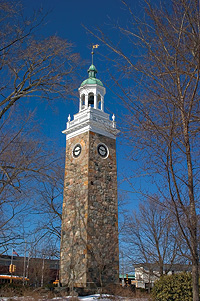 Wealthy Bostonians came to the elegant Elm Park Hotel (the old Needham Hotel had been re-named for the rows of arching elms which the Grantville Tree Society planted along both sides of Washington Street) for the entire summer, to partake of the “salubrious air.” (The health value of the Hills became so well-known as a cure for consumption that town leader Joseph Fiske wrote, “hundreds of people have made their residence here because the alternative seemed to be Heaven.”)
Wealthy Bostonians came to the elegant Elm Park Hotel (the old Needham Hotel had been re-named for the rows of arching elms which the Grantville Tree Society planted along both sides of Washington Street) for the entire summer, to partake of the “salubrious air.” (The health value of the Hills became so well-known as a cure for consumption that town leader Joseph Fiske wrote, “hundreds of people have made their residence here because the alternative seemed to be Heaven.”)
While you would go into West Needham square for business, you’d go to Grantville for fashion, dinner parties, clubs, philanthropy, and the town’s social life. And although the Grantville residents joined with the rest of the town in the battle for West Needham’s independence from Needham (Grantville resident John Shaw chaired the movement), upon success in 1881 they immediately asserted their independence and adopted the name Wellesley Hills.
The area enjoyed its separate way of life, with its own Town Improvement Society, post office, railroad, schools, clubs, churches (including the Unitarian Society, established in 1871), and fire station (the 1889 wooden building served for nearly a century, until a replacement was built in 1987).
A catalog for the nearby Rock Ridge Hall (a private school) boasted: “It is believed that this village (Wellesley Hills) is absolutely free from all evil influences which tend to corrupt youth.”
And what is the Hills like in 2007? Approaching it from Newton on Washington Street, you pass along a plateau (Croton, Elm, Pine Streets) which was called “the Plain” in the 1800s, when there were scarcely any homes to break the harsh sweep of winter winds, and where children ran to watch huge droves of cattle being driven on their way to the slaughterhouse in Brighton.
Today, “the Hills is different from other areas of town because it feels like a village, where you can walk everywhere—to get ice cream at Brigham’s, pizza at Nick’s, groceries at Whole Foods; to the Warren playground, or to church,” says Greg Mills. “And we’re surrounded by extraordinary physical reminders of our special history, quite distinctive and interesting.”
As you continue past the Plain, the first of these significant landmarks is the Hills Congregational Church, a stunning stone building which feels like something you’d find in England. In fall, its lawn is covered by hundreds of pumpkins for the annual sale; in spring, it opens its doors for the rummage sale; year-round it houses the Wellesley Food Pantry and the Nursery School in the Hills.
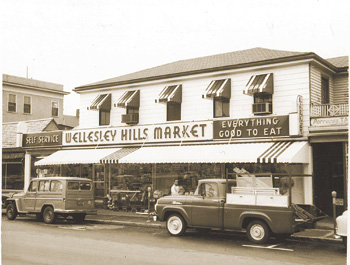 Church Moderator Becky Epstein says, “The church has been an important part of the Hills neighborhood for more than 160 years. As a community of faith, we realize the importance of extending a hand to our neighbors. We look back with humility on a past marked by a demonstrable legacy of service, even as we work diligently to enrich our present, not only for our church, but for the entire Hills community.”
Church Moderator Becky Epstein says, “The church has been an important part of the Hills neighborhood for more than 160 years. As a community of faith, we realize the importance of extending a hand to our neighbors. We look back with humility on a past marked by a demonstrable legacy of service, even as we work diligently to enrich our present, not only for our church, but for the entire Hills community.”
Next door are two more buildings that play important roles in Wellesley’s life: the Wellesley Community Center (started by residents in 1972, echoing back to the role Maugus Hall had played in the Hills a century and a half earlier), and the Wellesley Historical Society (housed in the 1824 farmhouse of Daniel Dadmun, who had been a tollkeeper on the Worcester Turnpike).
Just across the street is the cozy little Hills Branch Library, which until last year was the warm heart of the neighborhood, known by children and seniors alike for its annual Maypole dance, gerbils, staff who felt like old friends, and nooks and crannies overflowing with books. A lack of funds closed its well-worn doors, but Library Trustees and its fiercely devoted supporters are battling to re-open it.
“Everyone was devastated when our library closed; there was an outpouring of sadness and regret,” says neighbor Amanda Henshon, who is also a Trustee. “But we’re hopeful it can re-open.
“It was the core of this neighborhood, which has an incredibly strong sense of community. It’s warm and friendly in the Hills, that’s what makes it wonderful. We don’t ever want to leave.”
From the vantage point of his Windsor Press, Tory DeFazio watches the same streets he has observed for seven decades. His perspective is unique: the building was the site of his grandparents’ grocery store, was his childhood home, and housed the Hills’ first telephone office in 1894 (reportedly haunted) and the first post office in 1920.
“The atmosphere here is still very small-townish, very different from the Central Street area,” DeFazio says. “There are a number of little family-owned shops, and thriving life on the street. You walk down the sidewalk, run into people you know, pick up lunch, and eat in the park.”
The Hills’ equivalent of “Cheers” is the Maugus Restaurant (named after the Indian chief who lived here 400 years ago), which, for 70 years, has anchored its block of similar locally-owned stores. The regulars have their own tables—at 7 a.m. you can find the Republicans in the back corner, and their more liberal compatriots in the front by the window. When longtime customer Rollie Hall died after decades of eating at the same table nearly every day, the owners, the Papakonstantinou family, gave his chair to his daughter. “It’s like retiring his number,” Charlie Papakonstantinou says.
“We love being part of the Hills family,” says Charlie. “It’s nice for people to be able to go into a restaurant where they’ll always see the same faces. And all the store owners here know each other; we take care of each other. It’s a privilege to be part of the tradition, of giving the Hills a real center and preserving its character.”
And that character includes strong community ties. There are annual block parties in each mini-neighborhood. The Elm Street area has a Labor Day weekend gathering for more than 100 families, complete with bouncy castles, doughnut-eating contests, a barbecue, tug-of-war, and face-painting; and in late winter the adults hold a progressive potluck dinner, hosted at a number of different homes.
The Maugus Avenue area has its own summer party, “and that’s a delightful way to welcome new families,” says Sara Johnson. “This is a small, very friendly neighborhood with access to everything you need. I’ve lived here for nearly 30 years because I enjoy the wonderful neighbors, the scenic walks, the convenience, and the location. It combines the best of country trails and city access.”
It’s also a neighborhood that takes care of its own. There’s an e-mail list to keep everyone informed of activities, news, and illnesses (meal deliveries are organized for families recovering from hospitalizations and funerals). Community spirit also blossoms at Halloween and Christmas, when houses are richly decorated. At Halloween, residents talk of giving out up to 200 candy bars to a “non-stop trail of kids.”
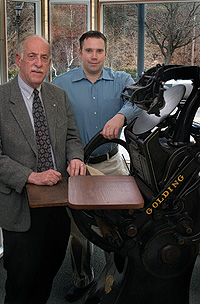 “This is a wonderful place to bring up children,” says Amanda Henshon, who has three boys, ages five, three and two. “We’re surrounded by warm, welcoming families, and there are so many young children around that whenever we want to socialize, all we have to do is walk out the door and there’s always someone to play with.” Sometimes they’ll head up the street to the fire station, where the firefighters seem delighted to show the children around and let them sit in the engines.
“This is a wonderful place to bring up children,” says Amanda Henshon, who has three boys, ages five, three and two. “We’re surrounded by warm, welcoming families, and there are so many young children around that whenever we want to socialize, all we have to do is walk out the door and there’s always someone to play with.” Sometimes they’ll head up the street to the fire station, where the firefighters seem delighted to show the children around and let them sit in the engines.
Because the Aqueduct Trail runs right through the Hills, favored activities include biking and dog-walking on winding paths that stretch from Phillips Park to the Brook Path, Centennial Park, and Longfellow Pond. “People walk a lot, and that encourages interaction and new friendships,” Mills says. “It’s really a very friendly, open social community.”
It’s also a politically active one. Although community organizing is now done by e-mail rather than by meeting at Benjamin Mills’ tavern, residents still follow the outspoken activist agendas of their predecessors. In the 1980s, the Wellesley Hills Neighborhood Association began to confront several major issues, including development of the 1894 Phillips School (the town’s first central high school).
“Those issues really brought people in the neighborhood together,” says Sara Johnson, who went on to become a Selectman, Library Trustee, and member of the Advisory Committee after this introduction to local politics. “We gained a great appreciation of open space in the area and an eagerness to preserve it. We’re dedicated to protecting our neighborhood from high-density development.”
Greg Mills finds the area “a hot bed of grassroots civic involvement,” including the successful work of neighborhood groups formed to support sidewalk installation along Woodlawn Avenue, and to add a playground to Warren Park.
One of the strongest area traditions is the Wellesley Hills Woman’s Club. Founded in 1890 for “the purpose of promoting ethical, social, and educational culture” (one of its first activities was the “Indian Pageant of the Trees,” featuring members as nymphs), it is the oldest organization in town.
“For 117 years, we’ve been a venue for women to get together in a social setting, with the ultimate end goal of doing good for our town,” says club President Suzanne Fredericks, noting that in addition to their century-old scholarship trust, they also make donations to many town groups. “We feel a sense of pride being part of a long history of service begun in the Hills so many years ago.”
More than 60 years ago, the Wellesley Hills Junior Woman’s Club spun off from its mother club, and has become one of the most active service groups in town, annually giving more than $80,000 in scholarships and a comparable amount to community organizations and projects. “Through our direct service projects and annual donations to charitable organizations and scholarships, we are very proud to continue the tradition of service begun by our founders in 1944,” says President Carolyn Wood.
The three themes of life in the Hills—community service, neighborhood spirit, and a sense of history—all come together best in the place that is the physical and emotional heart of the Hills: Clock Tower Park, also known as Elm Park.
Residents fought to preserve this area as open space when the hotel was torn down a century ago, buying the park by public subscription, and, in 1928, erecting a Clock Tower to honor beloved neighbors. Designed by resident Benjamin Proctor Jr. (who also designed the Kingsbury School), it was built of local fieldstone donated by Isaac Sprague (who also gave the stones for the Hills Library, Sprague School, and the Central Street fire station).
Sixty-five feet high and currently pending for inclusion in the National Registry of Historic Places, it houses the clock and “pleasant-toned” bell presented to the town in 1874 (and originally housed in the Shaw School) by Judge John Shaw, who lived on the land that became the park, and later led the fight for separation from Needham. A plaque commemorates him and “the little group of good citizens of the 1860s and 1870s to whom we owe so much.” The December 30, 1927 Townsman noted that the location would become “a point of distinction and beauty for the center of Wellesley Hills.”
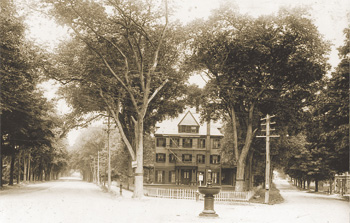 And that it has. When it was founded more than 50 years ago, the Hills Garden Club, following in the tradition of local civic improvement groups, adopted the park as its beautification project, working year round to plant perennials, decorate the tower with wreaths, and clean up the grounds. Each October, members plant nearly 1,000 tulip and daffodil bulbs; in the spring as the snow melts, the park turns into a blaze of vibrant reds and yellows.
And that it has. When it was founded more than 50 years ago, the Hills Garden Club, following in the tradition of local civic improvement groups, adopted the park as its beautification project, working year round to plant perennials, decorate the tower with wreaths, and clean up the grounds. Each October, members plant nearly 1,000 tulip and daffodil bulbs; in the spring as the snow melts, the park turns into a blaze of vibrant reds and yellows.
“Everyone takes a lot of pride in the tradition of caring,” says club president Pam Drouin. “It’s the first green space you see when you come into town from the east. It’s such a landmark, the symbol of the Hills. We’re devoted to it, it’s our baby. Neighbors say they love looking forward to the flowering every spring.”
For the club’s 50th anniversary, and in conjunction with a grant from the town’s Community Preservation Committee, it undertook major improvements including installation of historically accurate wrought iron fencing, brick walkways, Victorian benches and picnic tables, and lighted stone pillars. In an echo of centuries-old cooperation, the Wellesley Rotary Club donated lighting for the Tower, a generous gift to the town to celebrate Rotary’s 100th birthday.
“The Clock Tower symbolizes the Hills, and unifies it,” says Tory DeFazio, who has looked out on the park almost every day of his life. “It brings together history, beauty, and community involvement. It truly is the heart of what makes this neighborhood so special.”



recent comments